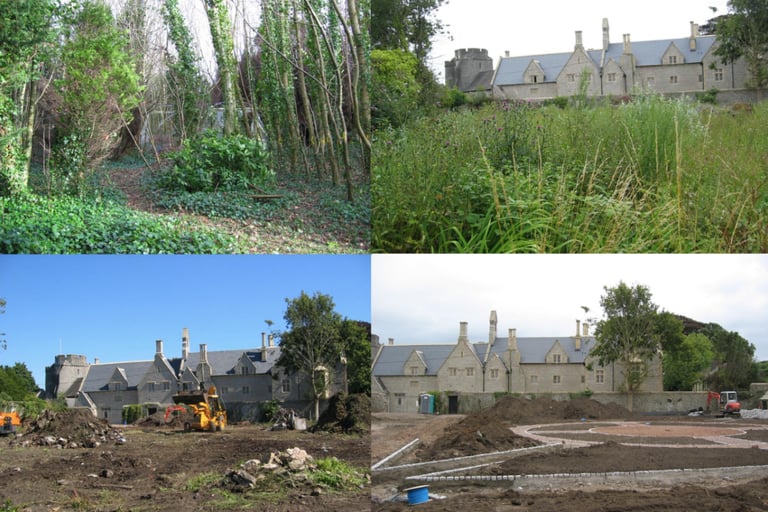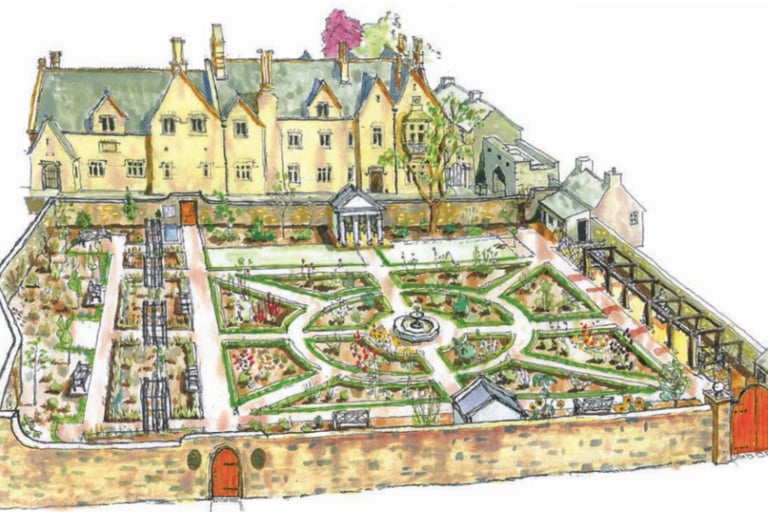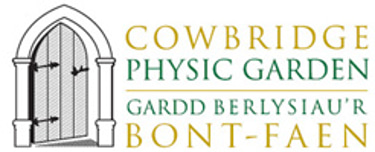History of the Garden
The Physic Garden is located within the Old Hall grounds in the centre of Cowbridge and is bounded on its south side by the medieval town wall.
In the mid eighteenth century the Edmondes family acquired Old Hall, a house fronting the High Street. They improved the house and developed the gardens. The Edmondes family were prominent landowners in the 18th century. Records show that in the nineteenth century, the walled enclosure in the south-east corner of the gardens was formally laid out with beds and paths, a layout which suggests an earlier origin. This is where the Physic Garden has been created, its formal design echoing the pattern of earlier centuries.
After the departure of the Edmondes family from Old Hall in the 1920s the Physic Garden site became, successively, a kitchen garden for Cowbridge Grammar School and a tree nursery for the Local Authority.
Neglected for many years thereafter, by the end of the twentieth century it was an overgrown wilderness.
Its transformation into the Physic Garden has been the work of the Cowbridge Physic Garden Trust, a charitable body set up to carry forward a project initiated by the South & Mid Glamorgan Branch of the Welsh Historic Gardens Trust.


In 2004, with the support of the Vale of Glamorgan Council, a group of volunteers had the vision to create the Physic Garden that is in existence today. Clearance of the site began early in 2005. Landscaping and construction work started in August 2005 and was completed in August 2006. Planting then began and the public was admitted to the garden in progress. Thanks to the committed work, enthusiasm and successful fund raising, the ancient walls and building were repaired, beds laid out, plants sourced and put into the ground, transforming the garden into what you see today. In June 2008 the Physic Garden was officially opened by HRH The Duchess of Cornwall. With careful nurturing, volunteers maintain the garden to an exceptionally high standard, something recognised by the garden winning Green Flag Awards for each of the past nine years and receiving the highest accolade in the RHS Wales in Bloom ‘It’s your neighbourhood’ category.
The layout and content of the garden are typical of the C18th, incorporating the formal, the functional (not only medicinal, but also culinary, perfumery, cosmetics and dyestuffs) and the aesthetic. Only plants found in Britain before 1800 are included in the garden.
Twelve central beds are devoted to plants which, over many centuries, have had medicinal properties attributed to them, and some of which have a recognised medicinal value today. Each of these beds contains plants specific to a part of the body or a particular illness and each bed is appropriately labelled (Kidneys, Eyes, Nerves, and Lungs etc.).
In the areas around the perimeter of the garden the emphasis is on colour and fragrance, but here again the medicinal and ‘soothing’ value of the plants is recognised. Fruit trees include apple, pear, walnut, quince and mulberry. The vines trained against the walls were a gift from Cowbridge's twin town of Clisson.
The tranquil atmosphere of the Physic Garden is enhanced by the central fountain. Seats in the pavilions and alongside the paths enable visitors to enjoy the Garden at leisure.
What is a Physic Garden?
The tradition of physic gardens stretches back a number of centuries; in Britain, the first to be established was the University of Oxford Botanic Garden, founded in 1621.
Known originally as “apothecaries gardens”, many monasteries and large estate mansions had physic gardens where plants were grown for cooking, healing and dyeing wool and fabric. They were also known as kitchen gardens or potagers (in French: jardin potager).
One of the most famous is the Chelsea Physic Garden, planted just a few years after the Oxford Botanic Garden. It was regarded as the most richly stocked garden in the world and had a flourishing seed exchange programme. It is reputed to have been responsible for providing the first cotton seeds to the American southern state of Georgia that grew into vast cotton plantations.
Plants have been a source of healing and nutrition for centuries; we have monasteries from the Middle Ages to thank for many of the medicinal remedies that must have originally been based on trial and error.
Plants such as sage, rosemary, mint, thyme and borage were grown in the infirmary garden of monasteries and used to prepare ointments, cordials, infusions and purgatives for the treatment of the monks themselves and the local people in the vicinity. Today, we still rely on the curative properties of plants in over 50% of our medicines.


Visitors may be surprised to see what they may consider to be “weeds” thriving in the garden – but plants such as dandelions and thistles are regarded as important in medical herbalism, and deserve their place in any physic garden, together with the more “romantic” plants such as mkeadowsweet, lemon balm and comfrey.
The Cowbridge Physic Garden is laid out in line with traditional physic gardens, where plants and herbs are grouped together in relation to their healing/soothing properties to different parts of the body or medical conditions. The planting has also taken history into consideration; all the plants in the Cowbridge Physic Garden were to be found in Britain before 1800.










Registered Charity Number: 1110127 Company Number: 5118600 Registered Office: The Old School House, Colwinston, Cowbridge, CF71 7NE
